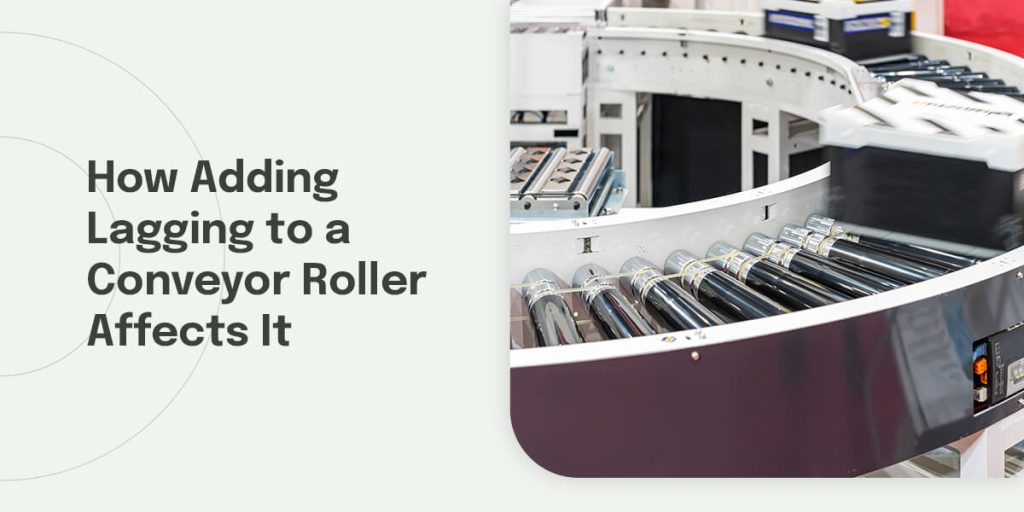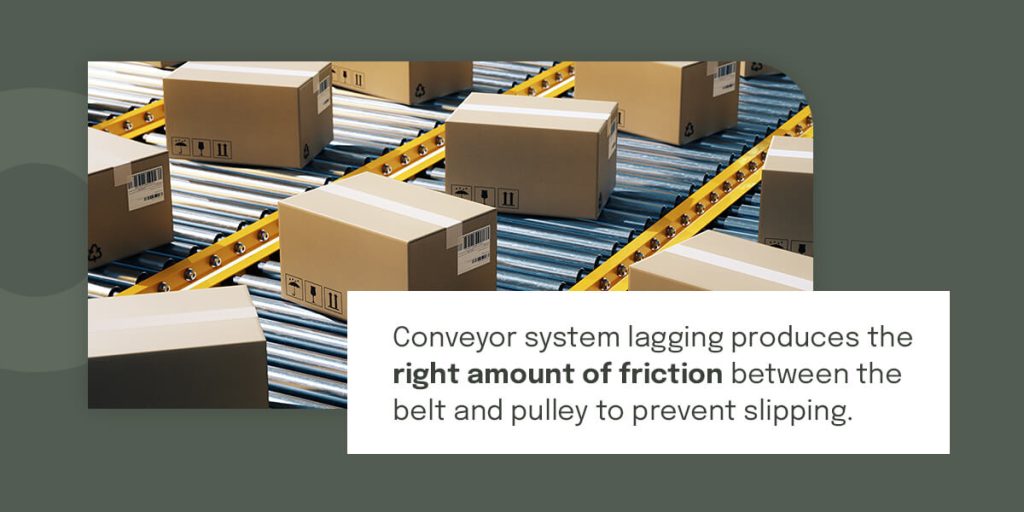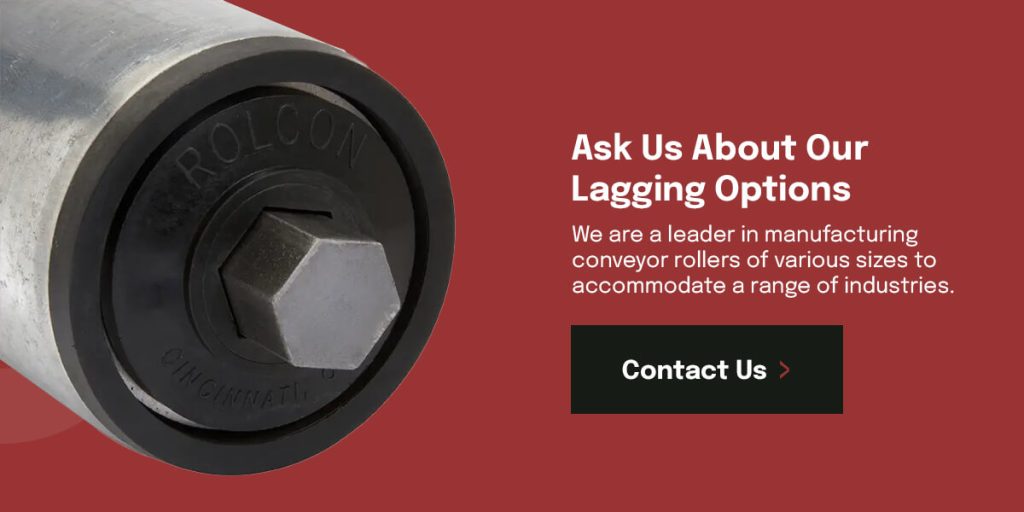
One way to maximize the productivity of a roller conveyor system is lagging. Whatever your material handling needs, lagging is added to a pulley or roller to increase friction. It’s made from materials such as rubber and carboxylated nitrile and comes in different patterns and application methods. Adding lagging to conveyor rollers and pulleys can improve your entire operation.
At Rolcon, we create lagging options to meet your specifications. Our engineers work one-on-one with you to understand the various components of your system and which lagging technique will work best. We customize our lagging and replacement rollers to your needs to keep productivity to a maximum and downtime to a minimum.
What Is Lagging?
Lagging refers to the different materials that coat a conveyor roller or pulley’s surface. It includes various compounds like rubber and silicone and patterns like smooth or diamond that you can apply using distinct methods to support the exact materials you work with. Two common application techniques are vulcanization or replaceable solutions like sleeving.
Lagging enhances traction between the pulley and the belt, delivering essential benefits to material handling industries across the board. Each type of conveyor roller lagging has different specifications and variations to support various applications. With the right lagging for your conveyor belt system, you can ensure proper friction and experience other advantages.
Benefits of Lagging for Conveyor Rollers and Conveyor Systems
Conveyor roller lagging delivers advantages to your operations no matter what type of material you work with. Here are some of the top benefits of adding lagging to your conveyor system:
- Boosts belt life span
- Prevents belt slipping
- Improves roller and belt alignment
- Ensures line operation and productivity
- Increases traction between conveyor belts and pulleys
- Prevents excessive wear on the drive, bearings, belt, pulleys and take-up
- Protects roller surfaces from damaging materials like abrasives, chemicals and rocks

Conveyor system lagging produces the right amount of friction between the belt and pulley to prevent slipping. Lagging can also stabilize alignment between parts and protect your custom conveyor rollers from harsh materials that can cause damage. In short, lagging protects the rollers, prevents excessive wear and increases the life span of your conveyor system.
Types of Lagging
Before deciding on the best type of lagging for your belt conveyors, you’ll want to consider several features. Think about the following pulley and roller lagging characteristics to find the best fit for your facility:
- Capabilities: You’ll want to know what conditions the lagging material can withstand and what other materials it works well with.
- Wear: Find out the material’s strength and resistance levels and compare them to your specific application needs.
- Maintenance: Determine if you can replace the lagging on your own or whether you’ll need to rely on a third-party provider.
- Material: Lagging is available in several different materials. Work with professionals to find the right lagging type for your system.
- Properties: Depending on your application, you may need to know if the material provides excellent traction in wet environments or works well with abrasive materials.
Find out what the capabilities of the lagging solutions are. Do you need it to be resistant to extreme temperatures, oils, acids, or water? Ensure you select a lagging material compatible with the material being conveyed and its environment. When it comes to general wear and tear of the lagging material, think about its strength and resistance to abrasion. These aspects will determine its ability to resist wear while providing proper traction and longevity.
Next, consider how much maintenance is required for the lagging material. Some solutions are simple to replace, and you can maintain and replace them yourself. However, other lagging types require using re-lagging services outside your facility. Finding the right lagging material for your application can be challenging, which is why the professionals are here. We’ll help you determine what lagging thickness, length and materials will work for your unique applications.
You’ll also want to know the lagging’s expected life span and what release properties best suit the roller’s surface. For example, if you have a drive pulley operating in a wet environment, lagging with a grooved, herringbone or diamond pattern will be better than smooth lagging. If you work with abrasive materials, consider ceramic lagging rather than rubber materials for increased durability.
Lagging Materials
Common lagging materials include:
- Silicone
- Ceramic
- Urethane
- Neoprene
- Nitrile (NBR)
- Natural rubber
- Carboxylated nitrile (XNBR)
- Polyvinyl chloride (PVC) plastic
- Styrene-butadiene rubber (SBR)
- Ethylene propylene diene monomer (EPDM) rubber
Rubber lagging and ceramic are two of the most common materials used. Each material rates on a hardness scale from soft, medium soft and medium hard to hard and extra hard.
Lagging Patterns
Lagging is also available in different patterns, such as:
- Smooth
- Chevron
- Diamond
- Herringbone
- Aligner groove
- Circumferential groove
Lagging Configurations and Application Processes
Roller lagging comes in different configurations, including:
- Coatings: Coatings are liquids applied to the surface to provide a protective layer once cured.
- Bars and strips: These materials attach directly to the roller.
- Sleeves: These slide over the roller and pulley.
- Sheets: Sheets are wrapped onto rolls to cover the surface.
These various lagging configurations provide different benefits depending on your application.
There are even different methods for bonding the lagging to the pulley. Here are the most common:
- Vulcanized: Vulcanizing is a chemical process involving high temperature and pressure to adhere rubber to another material.
- Weld-on or bolt-on: Welding can bond materials to a roller permanently. Bolting is a similar solution.
- Weld-on diamond: Welding can be done in different patterns, like a diamond pattern.
- Slide-on smooth: A slide-on pulls over a roller without further application, similar to a sleeve.
Lagging Options From Rolcon
Several types of lagging options we offer at Rolcon include:
- SBR
- Nitrile
- EPDM
- Urethane
- Neoprene
- Spiral rough top
- Carboxylated nitrile
Our various lagging solutions support pulley styles like E and H series, hub types like fixed bore plates, and internal bearing and pulley configurations like flat face and single crown to center. We also offer herringbone and diamond chevron grooves in various sizes like O and B-section.
Ask Us About Our Lagging Options
Conveyor system lagging produces the right level of friction for your operations to prevent slipping, improve alignment, protect roller surfaces and prevent excessive wear, all while ensuring consistent production lines. Contact Rolcon to learn more about our lagging options or browse our replacement conveyor rollers.
We are a leader in manufacturing conveyor rollers of various sizes to accommodate a range of industries. Our engineers can custom design and build rollers to fit your unique specifications, and we also offer complimentary sprockets, roller chains and bearing assemblies. Our lagging and replacement conveyor rollers solutions are made in the U.S. and offered at competitive pricing. Whether you need custom rollers or faster lead times, we are your solutions provider.
